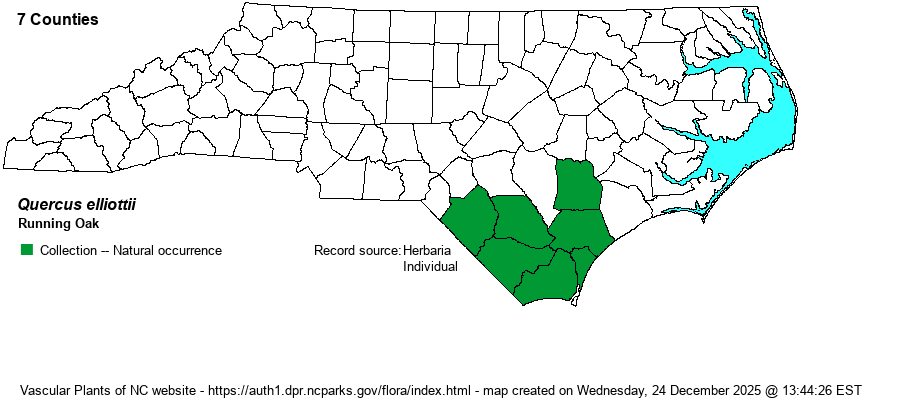| Section 6 » Family Fagaceae |
Show/Hide Synonym
| taxonName | relationship | relatedTaxonName | relatedTaxonRefText | relComments |
|---|
|
| Quercus elliottii | = | Quercus pumila | Flora of North America (1993b, 1997, 2000, 2002a, 2002b, 2003a, 2004b, 2005, 2006a, 2006b, 2006c, 2007a, 2009, 2010) | misapplied | | Quercus elliottii | = | Quercus pumila | | misapplied | | Quercus elliottii | = | Quercus pumila | Radford, Ahles, and Bell (1968) | misapplied | | Quercus elliottii | = | Quercus pumila | Small (1933, 1938) | misapplied | | Quercus elliottii | = | Quercus pumila | Wunderlin & Hansen Flora of Florida (3) | misapplied | | Quercus elliottii | = | Quercus pumila | Kubitzki in Kubitzki, Rohwer, & Bittrich (1993). | misapplied | | Quercus elliottii | = | Quercus pumila | | misapplied | | Source: Weakley's Flora |
|
| Author | Wilbur | |
| Distribution | Occurs only in the southern Coastal Plain; an outlier record from Union County in the southern Piedmont is apparently an error. The range, at least historically, reached to Duplin County.
This is a strict Coastal Plain species, ranging north to southeastern NC, and south to southern FL and southern MS.
| |
| Abundance | Rare and strongly declining over the past 30-40 years, owing to habitat loss and fire suppression; seemingly on the verge of extirpation in NC. Of the seven counties where it has been collected, only four have recent records. Within this small range, it can be intensely local, owing to the fact that it is clonal; one may see hundreds of plants, if any at all. Also, disconcerting is the fact that, as of 2020, hardly any of its known sites are on conservation lands. This was an NC Significantly Rare species, but was moved to a more deserving State Endangered status in May 2021. Its State Rank was elevated from S2 to now S1S2 in 2024, owing to the dire need for protection. | |
| Habitat | This is a species of pine flatwoods on rather specific soil types. These soils are generally loamy, with a high plant diversity if burned frequently. It does not occur in typical pine flatwoods over moist, sandy soil. Thus, the soil where it does occur is often quite dry, more like a “Mesic Pine Flatwoods” vegetation type. |
| Phenology | Flowers in March and April, fruits in September and October (of the first year). | |
| Identification | This is one of the few oaks that is a shrub, being a low, clonal tardily deciduous species that grows only to 1-2 feet tall; leaves can remain into early winter. The leaves are narrowly elliptic to oblanceolate, occasionally with shallow lobes near the tip; the leaf has a bristle tip. They are only 2-3.5 inches long, but are thick, very shiny dark green above, and downy whitish below. New spring leaves are a much brighter green and softer textured. Though seedling Willow Oak (Q. phellos), Laurel Oak (Q. laurifolia), or Darlington Oak (Q. hemisphaerica) can look similar when just knee-high, they have thinner leaves, not whitish tomentose below, and do not grow in low colonies. In summer or fall, presence of acorns on Running Oak will certainly end any confusion. Though there are likely a few locations for it in the southeastern counties that have yet been discovered, you likely will need to visit known sites, as several contain plants visible from public road margins, such as along O’Quinn Road in Robeson County. | |
| Taxonomic Comments | Formerly widely named as Q. pumila. Recent references generally agree now on the use of Q. elliottii as the correct name.
| |
| Other Common Name(s) | Runner Oak | |
| State Rank | S1S2 | |
| Global Rank | G3G5 | |
| State Status | E | |
| US Status | | |
| USACE-agcp | | |
| USACE-emp | | |

